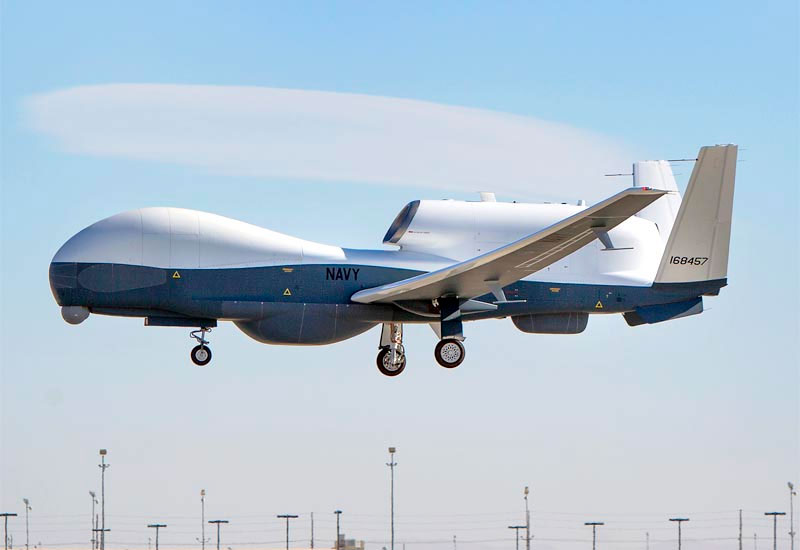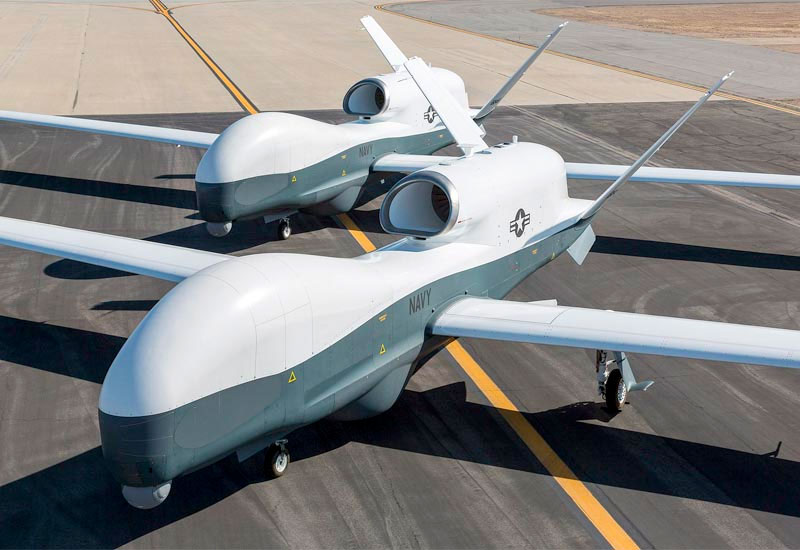The Northrop Grumman MQ-4C Triton is a high-altitude, long-endurance unmanned aerial vehicle (UAV) designed for maritime surveillance and reconnaissance.
The Northrop Grumman MQ-4C Triton is a high-altitude, long-endurance unmanned aerial vehicle (UAV) developed for maritime surveillance and reconnaissance missions. It operates at altitudes exceeding 50,000 feet (15,240 meters) and can endure flights over 24 hours, covering ranges up to 8,200 nautical miles (15,186 kilometers). Powered by a Rolls-Royce AE 3007 turbofan engine, the Triton achieves speeds up to 357 mph (575 km/h). Its design includes a wingspan of 130.9 feet (39.9 meters) and a length of 47.6 feet (14.5 meters). Equipped with advanced sensor suites, including maritime surveillance radar and electro-optical/infrared sensors, it provides real-time intelligence, surveillance, and reconnaissance (ISR) capabilities over vast ocean and coastal regions. The Triton complements manned aircraft like the Boeing P-8 Poseidon, enhancing the maritime patrol and reconnaissance capabilities of the United States Navy and the Royal Australian Air Force.
History of Development
In the early 2000s, the United States Navy identified a need for a persistent maritime surveillance system to address emerging global security challenges. The objective was to develop an unmanned aerial vehicle capable of providing continuous ISR over vast oceanic regions, complementing the capabilities of manned patrol aircraft. This led to the initiation of the Broad Area Maritime Surveillance (BAMS) program.
In April 2008, Northrop Grumman was awarded a contract to develop the BAMS UAV, building upon the existing RQ-4 Global Hawk platform. The new UAV, designated as the MQ-4C Triton, incorporated significant modifications to meet the Navy’s specific requirements for maritime operations. These enhancements included reinforced airframe and wing structures, de-icing and lightning protection systems, and advanced sensor suites tailored for maritime surveillance.
The MQ-4C Triton conducted its maiden flight on May 22, 2013, marking a significant milestone in its development. Subsequent testing phases focused on validating its sensor capabilities, endurance, and integration with other naval assets. In May 2018, the Triton achieved early operational capability, with the United States Navy beginning to integrate the UAV into its maritime patrol and reconnaissance force.
The development of the Triton was driven by the need for a platform that could provide real-time ISR over maritime domains, enhancing the Navy’s ability to detect, track, and monitor surface vessels and other maritime activities. The Triton operates in conjunction with the manned P-8A Poseidon aircraft, forming a comprehensive maritime patrol and reconnaissance system. This combination allows for a more efficient allocation of resources, with the Triton handling broad area surveillance and the P-8A focusing on anti-submarine and anti-surface warfare tasks.
Throughout its development, the Triton program faced challenges, including technical issues related to sensor integration and airframe modifications. However, continuous testing and iterative improvements addressed these challenges, leading to a robust and reliable platform. The program also emphasized the development of ground control stations and data dissemination systems to ensure that the intelligence gathered by the Triton could be effectively utilized by naval commanders and integrated into broader defense networks.
As of 2025, the United States Navy plans to procure a total of 68 MQ-4C Triton aircraft to enhance its maritime surveillance capabilities. Additionally, the Royal Australian Air Force (RAAF) has committed to acquiring up to seven Triton UAVs, with the first aircraft arriving in Australia in June 2024. The RAAF’s Tritons are expected to operate alongside their P-8A Poseidon fleet, providing comprehensive surveillance coverage over Australia’s maritime approaches and regional areas of interest.
The MQ-4C Triton represents a significant advancement in unmanned aerial technology for maritime applications. Its development reflects a strategic response to the evolving demands of naval warfare and the necessity for persistent ISR capabilities in maintaining maritime security.

Design of the MQ-4C Triton
The MQ-4C Triton features a high-altitude, long-endurance design optimized for maritime surveillance. Its airframe is based on the RQ-4 Global Hawk but includes several modifications to enhance its performance in maritime environments. The aircraft has a wingspan of 130.9 feet (39.9 meters) and a length of 47.6 feet (14.5 meters). The maximum takeoff weight is 32,250 pounds (14,628 kilograms). The airframe and wings are reinforced to withstand the stresses of rapid altitude changes and to provide durability in harsh maritime conditions. The wings are equipped with de-icing systems and lightning protection to ensure reliable operation in diverse weather conditions.
The Triton is powered by a Rolls-Royce AE 3007H turbofan engine, which provides the necessary thrust for high-altitude operations and long-endurance flights. The engine is designed for fuel efficiency, enabling the UAV to conduct extended missions without the need for refueling.
The sensor suite of the Triton is specifically tailored for maritime surveillance. It includes a 360-degree Multi-Function Active Sensor (MFAS) radar, which provides continuous radar coverage, allowing for the detection and tracking of maritime targets over vast areas. Additionally, the Triton is equipped with electro-optical/infrared (EO/IR) sensors, which enhance its ability to identify and classify targets visually. These sensors provide high-resolution imagery that is critical for situational awareness and intelligence gathering. The UAV also features an Electronic Support Measures (ESM) system, which detects and classifies radar emissions from other vessels and systems, enabling it to operate effectively in contested environments.
The aircraft’s robust communications systems allow real-time data transfer to ground control stations and naval assets. This ensures that intelligence gathered by the Triton can be promptly disseminated and utilized for operational decision-making. The UAV operates with a dual-payload architecture, enabling simultaneous use of its various sensors for comprehensive situational awareness.
The design of the MQ-4C Triton prioritizes durability and versatility. The reinforced structure and advanced sensors provide reliability in challenging maritime conditions, while its high-altitude capability minimizes the risk of detection and engagement by adversaries. However, the Triton’s lack of armament limits its ability to engage threats directly, relying instead on coordination with other naval assets for combat operations.
Performance of the MQ-4C Triton
The MQ-4C Triton boasts impressive performance metrics, making it one of the most capable UAVs for maritime ISR missions. It operates at a maximum altitude of 56,500 feet (17,220 meters), allowing it to cover wide areas and remain out of reach of most surface-to-air threats. The aircraft’s operational range is 8,200 nautical miles (15,186 kilometers), enabling it to monitor vast oceanic regions without requiring frequent refueling.
Powered by the Rolls-Royce AE 3007H turbofan engine, the Triton generates approximately 8,917 pounds (40 kN) of thrust. This engine is specifically designed for high fuel efficiency, ensuring extended mission durations of over 24 hours. The UAV’s cruise speed is approximately 357 mph (575 km/h), balancing speed and fuel economy to maximize its endurance.
The Triton’s advanced radar system provides 360-degree coverage with a range exceeding 2,000 nautical miles (3,704 kilometers). This capability is crucial for maritime surveillance, as it enables the detection and tracking of surface vessels, aircraft, and other targets over extensive areas. The radar’s high resolution allows for precise target identification, even under adverse weather conditions.
Compared to similar platforms like the General Atomics MQ-9 Reaper and the RQ-4 Global Hawk, the Triton excels in its maritime-specific capabilities. While the MQ-9 Reaper is a versatile UAV, its range and endurance are significantly lower than those of the Triton. The Global Hawk, although similar in design, lacks the Triton’s specialized maritime adaptations, such as its reinforced airframe, de-icing systems, and maritime surveillance radar.
However, the Triton’s reliance on unarmed surveillance roles limits its versatility in direct combat scenarios. Competitor UAVs like the MQ-9 Reaper, which can carry a variety of weapons, offer greater flexibility for strike missions. Nonetheless, the Triton’s primary focus on ISR makes it an indispensable asset for maritime security operations.
Variants of the MQ-4C Triton
The MQ-4C Triton program includes several variants tailored to meet specific operational requirements. The baseline model is designed for maritime ISR missions, equipped with the full suite of sensors and communication systems.
A notable variant under development is the MQ-4C Triton Multi-INT (Multi-Intelligence) configuration. This version incorporates additional sensors to enhance its intelligence-gathering capabilities, particularly in contested environments. These enhancements include signals intelligence (SIGINT) equipment, which enables the detection and analysis of electronic emissions from adversary systems.
The Australian variant of the Triton, operated by the Royal Australian Air Force (RAAF), shares the core features of the baseline model but includes modifications for integration with Australian defense systems. These adaptations ensure compatibility with existing Australian surveillance and reconnaissance networks.
While the Triton family remains relatively specialized, its modular design allows for future upgrades and modifications, ensuring its adaptability to evolving operational needs.

Military Use and Combat of the MQ-4C Triton
The MQ-4C Triton serves primarily as an ISR platform, focusing on maritime domain awareness. Its primary operators are the United States Navy and the Royal Australian Air Force. The UAV plays a crucial role in monitoring oceanic regions, identifying potential threats, and supporting naval operations.
The Triton has not been directly involved in armed conflicts, as it is unarmed. Instead, it provides critical support for combat operations by relaying real-time intelligence to decision-makers. For example, during maritime patrol missions in the Pacific and Indian Oceans, the Triton has been instrumental in tracking illegal fishing operations, smuggling activities, and the movement of naval assets from adversary nations.
In 2021, the Triton was deployed to monitor regional tensions in the South China Sea, where its long endurance and advanced sensors allowed for continuous surveillance of contested maritime zones. The UAV’s presence enabled the United States Navy to maintain situational awareness and support freedom of navigation operations.
The Triton has also supported humanitarian missions, such as search and rescue operations during natural disasters. Its ability to cover large areas quickly and provide high-resolution imagery has proven invaluable in locating survivors and assessing damage.
The aircraft’s export to allied nations like Australia highlights its strategic importance. The RAAF’s integration of the Triton enhances regional maritime security and strengthens interoperability with the United States Navy. While discussions of further exports are ongoing, the Triton’s high cost and specialized capabilities may limit its adoption by other nations.
As of 2025, the Triton remains an active component of the United States Navy’s maritime patrol force, complementing the P-8A Poseidon. Plans for future upgrades, including enhanced SIGINT capabilities, ensure its relevance in evolving operational environments.
The Northrop Grumman MQ-4C Triton represents a significant advancement in unmanned aerial technology for maritime surveillance. Its combination of high-altitude, long-endurance capabilities, advanced sensors, and robust design makes it a cornerstone of modern naval ISR operations. While its lack of armament limits its versatility, the Triton’s ability to provide real-time intelligence over vast areas ensures its continued importance in maritime security.
Back to the Drones, UAVs, UCAVs page